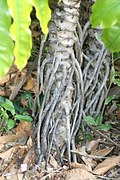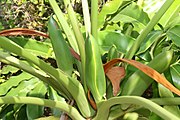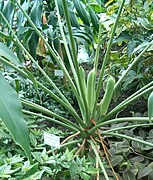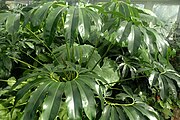Thaumatophyllum spruceanum
| Thaumatophyllum spruceanum | |
|---|---|

| |
| Location taken: Berlin Botanical Garden and Botanical Museum | |
| Scientific classification | |
| Kingdom: | Plantae |
| Clade: | Tracheophytes |
| Clade: | Angiosperms |
| Clade: | Monocots |
| Order: | Alismatales |
| Family: | Araceae |
| Genus: | Thaumatophyllum |
| Species: | T. spruceanum
|
| Binomial name | |
| Thaumatophyllum spruceanum | |
| Synonyms[1] | |
| |
Thaumatophyllum spruceanum is a neotropical hemiepiphytic or scrambling plant in the genus Thaumatophyllum, in the family Araceae. It is native to northern South America.[1]
Description[edit]
Thaumatophyllum spruceanum is noted for its unusually hoop-shaped, parallel-pinnately veined, pedately divided leaves;[2] these are similar to those of the sympatric species Thaumatophyllum leal-costae.[3] Each leaf consists of 10-20 leaflets, with the central leaflet 18–50 cm long.[4]
T. spruceanum is self-heading (arborescent or tree-like) and occurs both as a terrestrial shrub in sandy soil along riverbanks and forest margins, and as a hemiepiphyte atop larger trees in dense forest.[5]
The fruit of T. spruceanum is edible and sweet, reminiscent of pineapple or banana.[5]
Taxonomy[edit]
The specific epithet spruceanum refers to botanist Richard Spruce, credited as being the first to collect specimens of the plant from the Amazon rainforest in 1851.[6]
Thaumatophyllum was originally erected as a monotypic genus in 1859, containing only T. spruceanum.[7] The species was later moved to Philodendron in 1962 by Graziela M. Barroso, placed alongside other members of what was then the subgenus Meconostigma.[8] Molecular phylogenetics research led by Cassia Sakuragui at the Federal University of Rio de Janeiro resulted in the recognition of Meconostigma as monophyletic 2018, and the subsequent resurrection of Thaumatophyllum, with Meconostigma species being placed within it.[4]
Distribution[edit]
Thaumatophyllum spruceanum is native to the humid rainforest of northern Brazil, Colombia, Ecuador, French Guiana, Peru, Suriname, and Venezuela.[1]
Gallery[edit]
-
Location taken: Fairchild Tropical Botanic Garden, Miami.
-
Aerial roots and leaf scars on trunk of T. spruceanum.
-
Spathes surrounding flowers of T. spruceanum.
-
Flowers and petioles.
-
Location taken: Garfield Park Conservatory, Chicago
References[edit]
- ^ a b c d "Thaumatophyllum spruceanum", Thaumatophyllum spruceanum Schott, Plants of the World Online, retrieved 2023-04-22
- ^ Hay, A. (2019). "Durianology, discovery, and saltation — the evolution of aroids". Gardens' Bulletin Singapore. 71 (Suppl. 2): 279. doi:10.26492/gbs71(suppl.2).2019-20.
- ^ Mayo, S.J. (1990). "History and Infrageneric Nomenclature of Philodendron (Araceae)". Kew Bulletin. 45 (1). Springer on behalf of Royal Botanic Gardens, Kew: 37–71. doi:10.2307/4114436. JSTOR 4114436. Retrieved 22 April 2023.
- ^ a b Sakuragui, Cassia Mônica; Calazans, Luana Silva Braucks; Oliveira, Leticia Loss de; Morais, Érica Barroso de; Benko-Iseppon, Ana Maria; Vasconcelos, Santelmo; Schrago, Carlos Eduardo Guerra & Mayo, Simon Joseph (2018), "Recognition of the genus Thaumatophyllum Schott − formerly Philodendron subg. Meconostigma (Araceae) − based on molecular and morphological evidence", PhytoKeys (98): 51–71, doi:10.3897/phytokeys.98.25044, PMC 5943393, PMID 29750071
- ^ a b Madison, M. (1981). "Notes on some aroids along the Rio Negro, Brazil [1979]". Aroideana (USA). 2 (3): 71, 77. ISSN 0197-4033. Retrieved 22 April 2023.
- ^ Shmahalo, Olena. "DNA Analysis Reveals a Genus of Plants Hiding in Plain Sight". Quanta Magazine. Simons Foundation. Retrieved 23 April 2023.
- ^ Schott, H. (1859), "Aroideenskizzen", Bonplandia. Zeitschrift für die gesammte Botanik (in German and Latin), 7 (3): 26–31, p. 31
- ^ Mayo, S.J. (1991), "A revision of Philodendron subgenus Meconostigma (Araceae)", Kew Bulletin, 46 (4): 601–668, doi:10.2307/4110410, JSTOR 4110410





